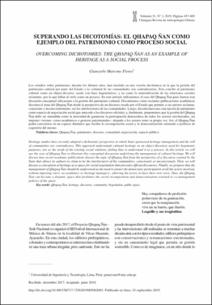Superando las dicotomías: el qhapaq ñan como ejemplo del patrimonio como proceso social
Abstract
Los estudios sobre patrimonio, durante los últimos años, han insistido en una versión dicotómica en la que la gestión del patrimonio cultural por parte del Estado y la voluntad de las comunidades son contradictorias. Esta concibe al patrimonio cultural como un objeto-discurso, usado con fines hegemónicos, y no como la materialización de las relaciones sociales existentes, por lo que fallan al verlo como un proceso. En este artículo utilizaremos el caso del Qhapaq Ñan para ilustrar esta discusión conceptual subyacente a la gestión del patrimonio cultural. Discutiremos cómo recientes publicaciones académicas discuten el tema del Qhapaq Ñan desde la perspectiva de un discurso creado por el Estado que permite a sus autores reclamar, consciente o inconscientemente, ser los interlocutores de las comunidades. Luego, discutiremos una concepción de patrimonio como espacio de negociación social que antecede a los discursos oficiales; y, finalmente, proponemos que la gestión del Qhapaq Ñan debe ser entendida como la necesidad de garantizar la participación democrática de todos los actores involucrados, sin imponer visiones -como académicos o gestores patrimoniales-, dejando a los actores tener su propia voz. Así, el Qhapaq Ñan podrá convertirse en un espacio dinámico que facilite la recomposición social y la democratización orientado a políticas de cogestión del mismo. Heritage studies have recently adopted a dichotomic perspective in which State-sponsored heritage management and the will of communities are contradictory. This approach understands cultural heritage as an object-discourse used for hegemonic purposes, not as the result of the existing social relations, failing thus to understand it as a process. In this article we will use the case of Qhapaq ñan to illustrate this conceptual discussion underlying the management of cultural heritage. We will discuss how recent academic publications discuss the topic of Qhapaq ñan from the perspective of a discourse created by the State that allows its authors to claim to be the interlocutors of the communities, consciously or unconsciously. Then, we will discuss a conception of heritage as a space for social negotiation that precedes official discourses. Finally, we propose that the management of Qhapaq ñan should be understood as the need to ensure the democratic participation of all the actors involved, without imposing views -as academics or heritage managers-, allowing the actors to have their own voice. Thus, the Qhapaq ñan can become a dynamic space that facilitates the social recomposition and democratization oriented to co-management policies of the space.


